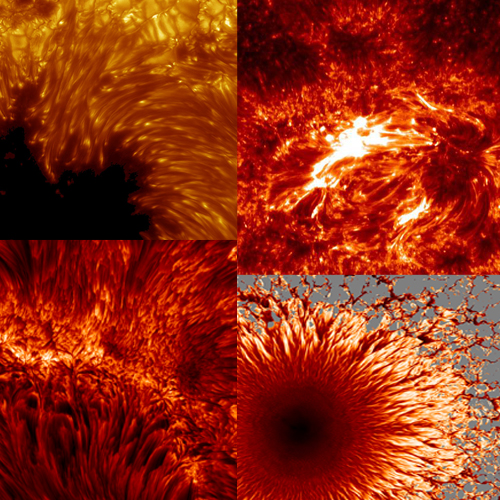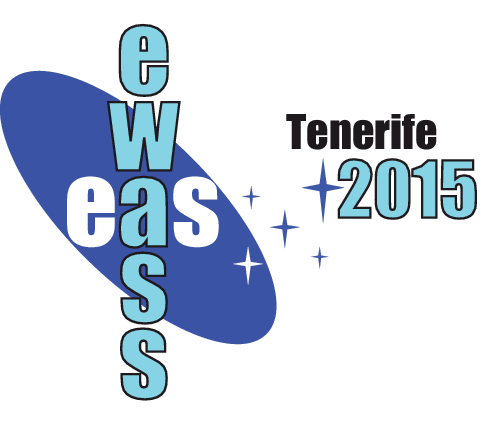Symposium S5
22 – 23 June 2015
The Sun under the microscope
Aims and scope
 During the last years, there have been considerable advances in high resolution Solar
Physics, reaching spatial scales in the range from 100-300 km. Telescopes like the Swedish
Solar Telescope (SST) at the observatory of El Roque de los Muchachos, the National Solar
Observatory's Dunn Solar Telescope (DST) at Sunspot, and the Vacuum Tower Telescope
(VTT) at El Teide observatory have significantly improved their observing capabilities. The
result of those efforts is a better understanding of the photospheric and chromospheric
magnetism, and the connectivity of those layers. The recently launched Interface Region
Imaging Spectrograph (IRIS) mission complements the successful Hinode satellite and
Sunrise balloon by observing the high chromosphere and the transition region with
unprecedented spatial resolution, providing interesting information expanding the ground-based results. The corona is also monitored at different temperatures with high resolution by the Solar Dynamics Observatory (SDO) satellite, providing clues to understand the mechanisms that heat the outer solar atmosphere up to million degrees.
During the last years, there have been considerable advances in high resolution Solar
Physics, reaching spatial scales in the range from 100-300 km. Telescopes like the Swedish
Solar Telescope (SST) at the observatory of El Roque de los Muchachos, the National Solar
Observatory's Dunn Solar Telescope (DST) at Sunspot, and the Vacuum Tower Telescope
(VTT) at El Teide observatory have significantly improved their observing capabilities. The
result of those efforts is a better understanding of the photospheric and chromospheric
magnetism, and the connectivity of those layers. The recently launched Interface Region
Imaging Spectrograph (IRIS) mission complements the successful Hinode satellite and
Sunrise balloon by observing the high chromosphere and the transition region with
unprecedented spatial resolution, providing interesting information expanding the ground-based results. The corona is also monitored at different temperatures with high resolution by the Solar Dynamics Observatory (SDO) satellite, providing clues to understand the mechanisms that heat the outer solar atmosphere up to million degrees.
Telescopes that are starting their lifetime, like GREGOR (El Teide), the New Solar Telescope
(NST; Big Bear Solar Observatory), and the New Vacuum Solar Telescope (Fuxian Solar
Observatory) are expected to deliver soon even better data that will improve our knowledge of
the fundamental processes that govern the solar atmosphere and provide a more accurate
and coherent vision of the physical phenomena in the different layers.
This symposium is aimed at presenting the best, up-to-date results from high-resolution solar observations with ground and space-based instrumentation. It will bring together the whole worldwide high-resolution Solar Physics community and sumarise the latest scientific achievements, including high resolution numerical simulations and diagnostic techniques, as
a way to get prepared for the next generation of solar telescopes: European Solar Telescope
(EST, Canary Islands) and Daniel K. Inouye Solar Telescope (DKIST, Hawaïi).
Programme
We have planned 6 invited reviews (IR) with a duration of 20 min, 7 invited talks (IT)
with a duration of 15 min, and 25 contributed talks with a duration of 10 min. Depending on the number of requested contributed talks, and up to 20 posters, will have a 1 min presentation at the end of some sessions.
- Session 1: Diagnostic techniques and numerical simulations
- Session 2: High resolutions observations of the solar photosphere
- Session 3: High resolutions observations of the solar chromospere, transition region, and corona
Invited speakers
- IR1 : Magneto-hydrodynamical simulations as a diagnostic tool for the solar atmosphere
S. Danilovic. Max Planck Institute for Solar System Research
- IR2 : The solar atmosphere under the high resolution lens of the SST
A. Ortiz. University of Oslo
- IR3 : First results of the GREGOR telescope for the solar photosphere
M. Franz Kiepenheuer Institut für Sonnenphysik
- IR4 : State-of-the-art inversions of high resolution spectro-polarimetric observations of the solar chromosphere.
J. de la Cruz. Stocholm University
- IR5 : Chromospheric and photospheric dynamics observed with the NST
A. Kosovichev. Big Bear Solar Observatory
- IR6 : First results of IRIS for the transition region
P. Testa. Harvard-Smithsonian Center for Astrophysics
- IT1 : State-of-the-art inversions of high resolution spectro-polarimetric observations of the solar photosphere
M. van Noort. Max Planck Institute for Solar System Research
- IT2 : Bayesian inference in Solar Physics
I. Arregui. Instituto de Astrofísica de Canarias
- IT3 : Seismology to understand the nature of solar prominences
M. Luna. Instituto de Astrofísica de Canarias
- IT4 : Multiwavelength observations to link the solar atmosphere
C. Kuckein. Leibniz Institute for Astrophysics Potsdam
- IT5 : Magnetic fields of chromospheric structures
D. Orozco. Instituto de Astrofísica de Canarias
- IT6 : The High resolution coronal imager
J. Cirtain NASA's Marshall Space Flight Center
- IT7 : Upcoming facilities for high resolution Solar Physics: DKIST, EST and Solar C
T. Schad. University of Hawaïi
Scientific organisers
María Jesús Martínez González. Chair. Instituto de Astrofísica de Canarias
Luis R. Bellot Rubio. Instituto de Astrofísica de Andalucía
Carsten Denker. Leibniz-Institut für Astrophysik Potsdam
Fernando Moreno Insertis. Instituto de Astrofísica de Canarias
Alexandra Tritschler. National Solar Observatory
Luc Rouppe Van Der Voort. University of Oslo
Contact
M. J. Martínez González (marian @ iac.es)
Updated on Mon Mar 30 17:10:06 CEST 2015
|

